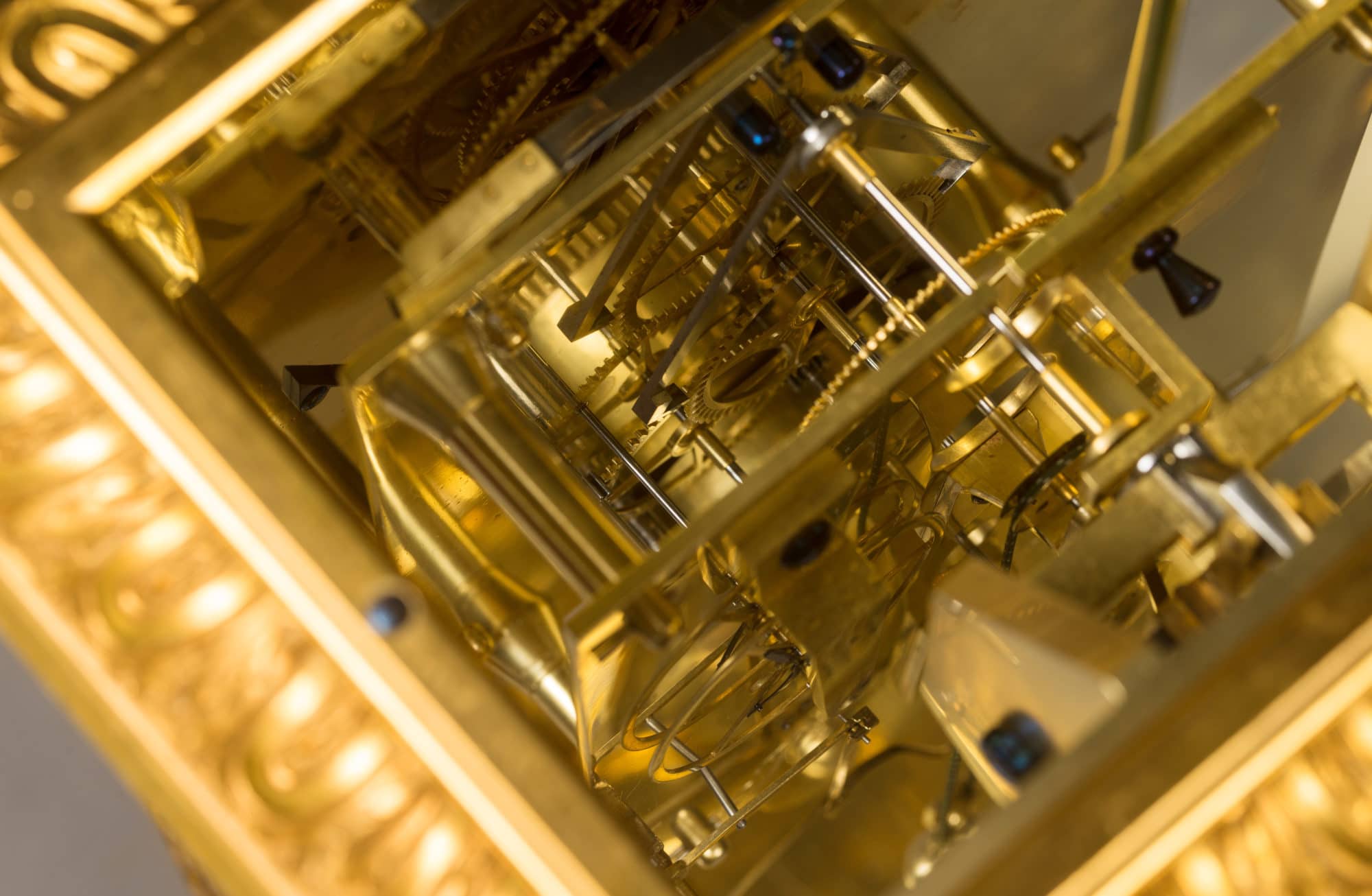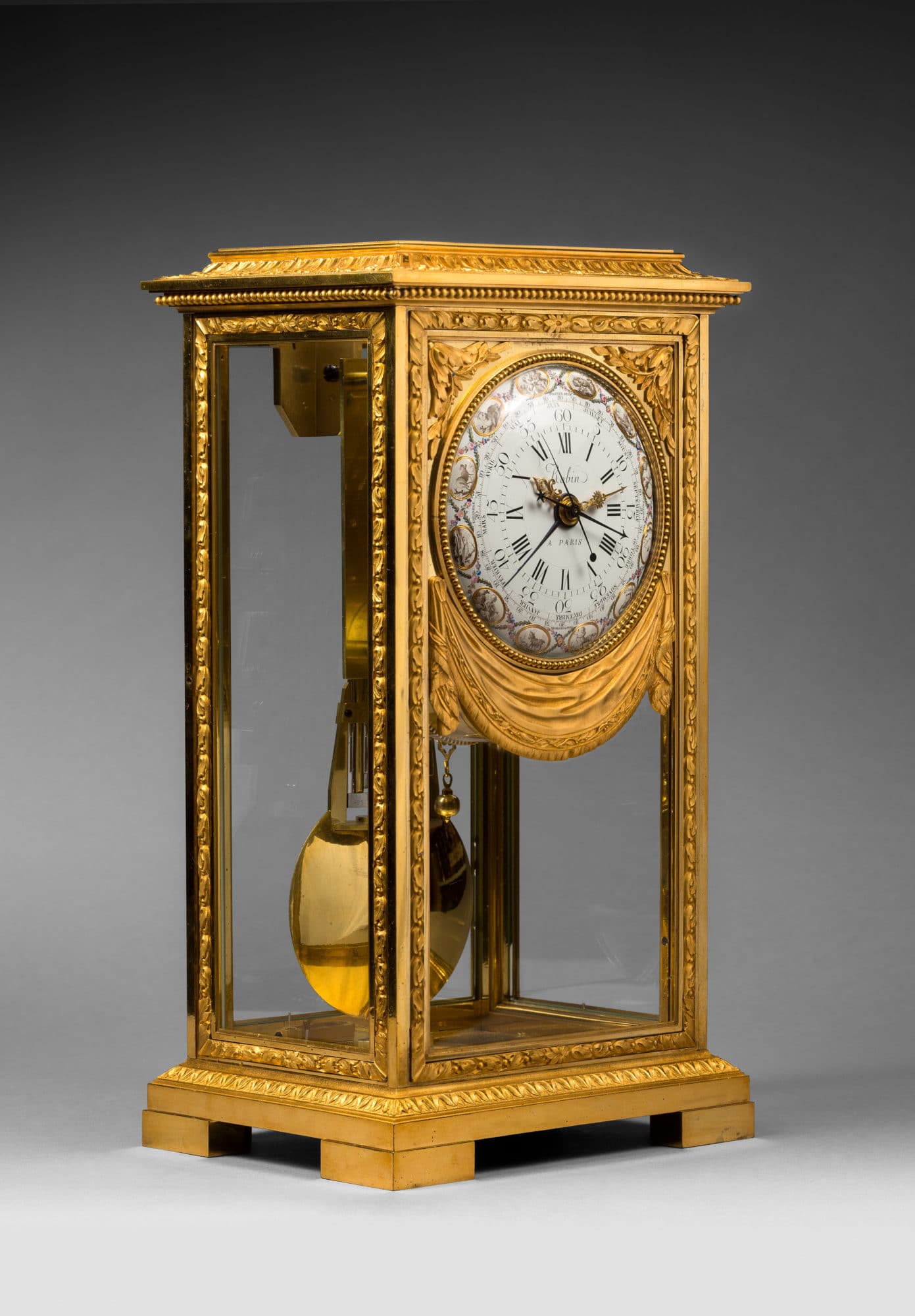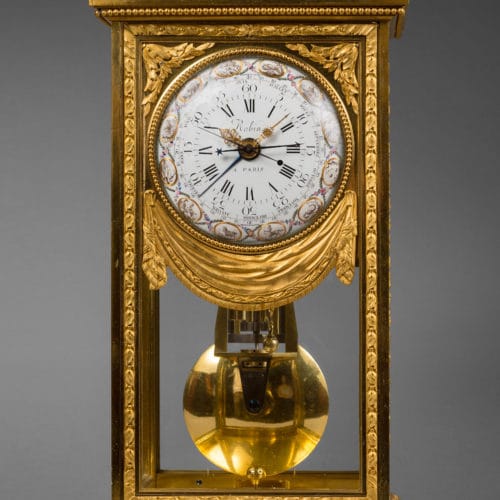Exceptional Desk Regulator with remontoir d’égalité
“Royal Model”

Case Attributed to Pierre-Philippe Thomire
Probably Made under the Supervision of Dominique Daguerre
Paris, Louis XVI period, circa 1780-1785
This exceptional desk, or mantel, regulator is one of the most luxurious Parisian clocks of the latter part of the reign of Louis XVI. Its complex movement with complications has a Graham escapement and a constant force remontoir d’égalité, with a bimetallic gridiron pendulum signed “Robin”; it is driven by two weights, with instructions for winding indicated on the back of the front door: “Remonté à gauche faite passer le quantième” (Wind to the left, make the date advance). The magnificent neoclassical architectural case is made of finely chased matte gilt bronze. All four sides, as well as the top, are glazed so that the complex movement may be admired. The case, which is raised on four quadrangular feet, is elaborately adorned with a molded frieze alternating with toothed and leaf friezes on the chapter, a bead frieze adorning the slightly protruding cornice and the bezel, with acanthus and laurel leaf spandrels, stylized leaves framing the front, a stylized leaf frieze adorning the base, and a magnificent chased drapery with fringe and a leafy garland under the dial.
The dial, signed “Robin à Paris”, is a true masterpiece; it also bears the signature of Joseph Coteau, the most famous enameler of the time. It indicates the Roman numeral hours, the Arabic numeral five minute intervals, the seconds, the date, the months, and the equation of time, showing the difference between real time and mean time. Along its outermost edge, it indicates the twelve signs of the zodiac painted in shades of gray within oval medallions framed by interlacing polychrome leaf and flower branches. There are four hands: one, made of pierced gilt bronze with a sun, indicates the equation of time. There are three other blued steel hands.
Discover our entire collection of luxury antique clocks and luxury desk clocks for sale online or at the gallery.
The present clock represents the quintessence of luxury Parisian horology of the Louis XVI period. This type of clock was intended for a small handful of connoisseurs, often individuals who were very close to the royal family. Certain contemporary documents give us information on the type of collector that might have owned such a masterpiece. One such clock was briefly mentioned in the probate inventory of Denis-Pierre-Jean Papillon de la Ferté, the director of the Menus Plaisirs du Roi, and was feature in the February 1797 sale of his collection: “305. A square shaped clock with glazed panels, half-second movement, with equation, remontoire and striking, made by Robin”. A second comparable clock was described a few years earlier, shortly after the Revolution, in an inventory of the horological collection of Queen Marie-Antoinette, which was maintained by Robin. It described a clock that was nearly identical to the present one: “28. A square clock with architectural case and glazed panels, in matte gilt bronze, with compensation pendulum, movement with hours, minutes, seconds, with striking, date, day of the week, the figures of the zodiac painted in miniature on the dial, by Robin” (see P. Verlet, Les bronzes dorés français du XVIIIe siècle, Paris, 1999, p. 466).
Among the small number of similar regulators known today, most bear the signatures of the clockmaker Robin and the enameler Coteau, who probably worked on the model at the request of one of the great marchands-merciers of the time, such as Simon-Philippe Poirier and his associate Dominique Daguerre, the most important Parisian suppliers of luxury objects. One comparable example now in a private collection is illustrated in D. Roberts, Precision Pendulum Clocks, 2004, p. 32. Two other regulators by Robin, formerly in the Winthrop Kellogg Edey collection, are in the Frick Collection in New York; their cases have been attributed to the well-known bronzier Pierre-Philippe Thomire (Inv. 1999.5.150 and 1999.5.151) (respectively illustrated in dans Tardy, La pendule française, 2ème Partie: du Louis XVI à nos jours, Paris, 1975, and in C. Vignon, The Frick Collection Decorative Arts Handbook, New York, Scala, 2015).
Robert Robin (1741 - 1799)
Having become a master horologist in November 1767, he was one of the most important Parisian horologists of the last third of the 18th century. He received the honorary titles of Valet de Chambre-Horloger Ordinaire du Roi et de la Reine in 1783 and 1786. He enjoyed an extraordinary career, distinguishing himself by his exceptional contribution toward the improvement of time measuring instruments.
In 1778, the Academy of Sciences approved two of his inventions, one of which led to the construction of an astronomic clock with a meridian traced on a pyramid, which was acquired by the Menus Plaisirs for Louis XVI that same year; Robin published a very detailed historical and mechanical description of that clock. He also made mantel regulators with astronomic indications and compensation balance, of which the Marquis de Courtanvaux, a man of science and a great connoisseur of precision horology, was one of the earliest acquirers. During the Revolution he made decimal watches and clocks. He worked in the Grande rue du Faubourg Saint-Honoré (1772), the rue des Fossés-Saint-Germain l’Auxerrois (1775), the rue Saint-Honoré in the l’Hôtel d’Aligre (1778) and the Galeries du Louvre in 1786.
For his desk regulators, Robin chose very sober architectural cases, which look extraordinarily modern to contemporary viewers. He always worked with the finest artisans of the day, including the bronziers and chasers Robert and Jean Baptiste Osmond, Pierre Philippe Thomire, François Rémond and Claude Galle, the cabinetmakers Jean-Henri Riesener, Ferdinand Schwerdfeger and Adam Weisweiler, the enamellers Barbezat, Dubuisson, Merlet and Coteau for the dials, and Richard and Montginot for the springs.
Robert Robin’s two sons, Nicolas Robert (1775-1812) and Jean-Joseph (1781-1856), were also fine clockmakers and ably continued to run their father’s workshop.
Discover our entire collection of rare clocks on La Pendulerie Paris.
Joseph Coteau (1740 - 1801)
The most renowned enameller of his time, he worked with most of the best contemporary Parisian clockmakers. He was born in Geneva, where he was named master painter-enameler of the Académie de Saint Luc in 1766. Several years later he settled in Paris, and from 1772 to the end of his life, he was recorded in the rue Poupée. Coteau is known for a technique of relief enamel painting, which he perfected along with Parpette and which was used for certain Sèvres porcelain pieces, as well as for the dials of very fine clocks. Among the pieces that feature this distinctive décor are a covered bowl and tray in the Sèvres Musée national de la Céramique (Inv. SCC2011-4-2); a pair of “cannelés à guirlandes” vases in the Louvre Museum in Paris (see the exhibition catalogue Un défi au goût, 50 ans de création à la manufacture royale de Sèvres (1740-1793), Musée du Louvre, Paris, 1997, p. 108, catalogue n° 61); and a ewer and the “Comtesse du Nord” tray and bowl in the Pavlovsk Palace in Saint Petersburg (see M. Brunet and T. Préaud, Sèvres, Des origines à nos jours, Office du Livre, Fribourg, 1978, p. 207, fig. 250). A blue Sèvres porcelain lyre clock by Courieult, whose dial is signed “Coteau” and is dated “1785”, is in the Musée national du château in Versailles; it appears to be identical to the example mentioned in the 1787 inventory of Louis XVI’s apartments in Versailles (see Y. Gay and A. Lemaire, “Les pendules lyre”, in Bulletin de l’Association nationale des collectionneurs et amateurs d’Horlogerie ancienne, autumn 1993, n° 68, p. 32C).
Pierre-Philippe Thomire (1751 - 1843)
Pierre-Philippe Thomire was the most important Parisian bronzier of the last quarter of the 18th century and the first decades of the following century. Early on in his career he worked for Pierre Gouthière, ciseleur-fondeur du roi, and toward the mid-1770’s began working with Louis Prieur. He later became one of the bronziers attached to the Manufacture Royale de Sèvres, creating the bronze mounts for most of the important creations of the day. After the Revolution, he purchased the stock of Martin-Eloi Lignereux, thus becoming the most important suppliers of furniture bronzes for châteaux and Imperial Palaces. In addition, he worked for a wealthy private clientele, both French and foreign, including several of Napoleon’s Marshals. Thomire retired in 1823.
Dominique Daguerre is the most important marchand-mercier (i.e. merchant of luxury objects) of the last quarter of the 18th century. Little is known about the early years of his career; he appears to have begun to exercise his profession around 1772, the year he went into partnership with Philippe-Simon Poirier (1720-1785), the famous marchand-mercier who began using porcelain plaques from the Manufacture royale de Sèvres to adorn pieces of furniture. When Poirier retired around 1777-1778, Daguerre took over the shop in the rue du Faubourg Saint-Honoré, keeping the name “La Couronne d’Or”. He retained his predecessor’s clientele, and significantly increased the shop’s activity within just a few years. He played an important role in the renewal of the Parisian decorative arts, working with the finest cabinetmakers of the day, including Adam Weisweiler, Martin Carlin and Claude-Charles Saunier, cabinetmaker of the Garde-Meuble de la Couronne, Georges Jacob, the bronziers and chaser-gilders Pierre-Philippe Thomire and François Rémond, and the clockmaker Renacle-Nicolas Sotiau. A visionary merchant who brought the level of French luxury goods to its highest point, Daguerre settled in England in the early 1780’s, having gone into partnership with Martin-Eloi Lignereux, who remained in charge of the Paris shop. In London, where he enjoyed the patronage of the Prince Regent (the future King George IV), Daguerre actively participated in the furnishing and decoration of Carlton House and the Brighton Pavilion. Taking advantage of his extensive network of Parisian artisans, he imported most of the furniture, chairs, mantelpieces, bronze furnishings, and art objects from France, billing over 14500£, just for 1787. Impressed by Daguerre’s talent, several British aristocrats, called on his services as well. Count Spencer engaged him for the decoration of Althorp, where Daguerre worked alongside architect Henry Holland (1745-1806). In Paris, Daguerre and his partner Lignereux continued to supply influential connoisseurs and to deliver magnificent pieces of furniture to the Garde-Meuble de la Couronne, which were placed in the apartments of Louis XVI and Marie-Antoinette. Daguerre retired in 1793, no doubt deeply affected by the French Revolution and the loss of many of his most important clients.











